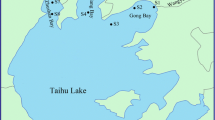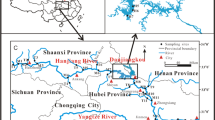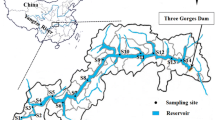Abstract
Seven estrogenic compounds—estrone (E1), 17β-estradiol (E2), 17α-ethynylestradiol (EE2), diethylstilbestrol (DES), nonylphenol (NP), octylphenol (OP), and bisphenol A (BPA)—in sediments, surface water, pore water, and organisms were investigated and estrogenic activities were estimated by examining estradiol equivalent (EEQ) concentrations in Yundang Lagoon of Xiamen. The results showed that estrogenic compounds were present in all matrixes of interest: in surface water, ranging from 609.61 to 711.31 ng/l; in pore water, ranging from 562.12 to 1038.15 ng/l; in sediments, ranging from 1433.12 to 2060.41 ng/g; and in biota samples, ranging from 1373.76 to 3199.09 ng/g (lipid weight). NP was the predominant component in all collected samples and the highest concentration was 1964.80 ng/g in sediment. Total EEQ ranged from 4.56 to 13.79 ng/l in surface water, from 2.40 to 17.16 ng/l in pore water, and from 8.66 to 23.95 ng/g in sediments. However, major contributors to total EEQ concentrations were E2, E1, and DES. The EEQ concentrations in surface water samples were at a higher level in comparison to that reported in European countries. To biological sample, the highest level of total estrogenic compounds was found in the short-necked clam. Higher values of the biota–sediment accumulation factor (BSAF) were found in short-necked clam and black seabream, indicating that the living habits of organism and physical–chemical properties of estrogenic compounds might influence the bioavailability of estrogenic compounds in organisms.




Similar content being viewed by others
References
Ahel M, Schaffner C, Giger W (1996) Behaviour of alkylphenol polyethoxylate surfactants in the aquatic environment: III. Occurrence and elimination of their persistent metabolites during infiltration of river water to groundwater. Water Res 30:37–46
Arditsoglou A, Voutsa D (2008) Passive sampling of selected endocrine disrupting compounds using polar organic chemical integrative samplers. Environ Pollut 156:316–324
Bacaloni A, Cavaliere C, Faberi A, Foglia P, Samperi R, Lagana A (2005) Determination of isoflavones and coumestrol in river water and domestic wastewater sewage treatment plants. Anal Chim Acta 531:229–237
Baronti C, Curini R, Dascenzo G, DI Corcia A, Gentili A, Samperi R (2000) Monitoring natural and synthetic estrogens at activated sludge sewagetreatment plants and in a receiving river water. Environ Sci Technol 34:5059–5066
Basheer C, Lee HK, Tan KS (2004) Endocrine disrupting alkylphenols and bisphenol-A in coastal waters and supermarket seafood from Singapore. Marine Pollut Bull 48:1161–1167
Beck I, Bruhn R, Gandrass J, Ruck W (2005) Liquid chromatography–tandem mass spectrometry analysis of estrogenic compounds in coastal surface water of the Baltic Sea. J Chromatogr A 1090:98–106
Belfroid AC, Van der Horst A, Vethaak AD, Schäfer AJ, Rijs GBJ, Wegener J, Cofino WP (1999) Analysis and occurrence of estrogenic hormones and theirglucuronides in surface water and waste water in The Netherlands. Sci Total Environ 225:101–108
Blackburn MA, Kirby SJ, Waldock MJ (1999) Concentrations of alkyphenol polyethoxylates entering UK estuaries. Marine Pollut Bull 38:109–118
Borga K, Gabrielsen GW, Skaare JU (2001) Biomagnification of organochlorines along a Barents Sea food chain. Environ Pollut 113:187–198
Brigitte G, Johannes W (2001) Comparison of an array of in vitro assays for the assessment of the estrogenic potential of natural and synthetic estrogens, phytoestrogens and xenoestrogens. Toxicology 166:79–89
Burkhard LP (2003) Factors influencing the design of bioaccumulation factor and biota-sediment accumulation factor field studies. Environ Toxicol Chem 22:351–360
Burkhard LP, Cook PM, Lukasewycz MT (2004) Biota-sediment accumulation factors for polychlorinated biphenyls, dibenzo-p-dioxins, and dibenzofurans in southern Lake Michigan lake trout (Salvelinus namaycush). Environ Sci Technol 38:5297–5305
Burkhard LP, Cook PM, Lukasewycz MT (2005) Comparison of biota-sediment accumulation factors across ecosystems. Environ Sci Technol 39:5716–5721
Campbell CG, Borglin SE, Green FB, Grayson A, Wozei E, Stringfellow WT (2006) Biologically directed environmental monitoring, fate, and transport of estrogenic endocrine disrupting compounds in water: a review. Chemosphere 65:1265–1280
Cargouet M, Perdiz D, Mouatassim-Souali A, Tamisier-Karolak S, Levs Y (2004) Assessment of river contamination by estrogenic compounds in Paris area (France). Sci Total Environ 324:55–66
Cheng CY, Liu LL, Wang WH (2006a) Determination and distribution characteristics of degradation products of nonylphenol polyethoxylates in the rivers of Taiwan. Chemosphere 65:2275–2281
Cheng CY, Liu LL, Wang WH (2006b) Occurrence and seasonal variation of alkylphenols in marine organisms from the coast of Taiwan. Chemosphere 65:2152–2159
Chrzan BG, Bradford PG (2007) Phytoestrogens activate estrogen receptor beta1 and estrogenic responses in human breast and bone cancer cell lines. Mol Nutr Food Res 51:171–177
Colborn T, vom Saal FS, Soto AM (1993) Developmental effects of endocrine disrupting compounds in wildlife and humans. Environ Health Perspect 101:378–384
European Commission (2008) Updated European Union risk assessment report: 4, 4′-isopropylidenediphenol (bisphenol-A). European Commission, Brussels, pp 119–120
Ferguson PL, Iden CR, Brownwell BJ (2001) Distribution and fate of neutral alkylphenol ethoxylate metabolites in a sewage-impacted urban estuary. Environ Sci Technol 35:2428–2435
Folmar LC, Hemmer MJ, Denslow ND, Kroll K, Chen J, Cheek A, Richman H, Meredith H, Grau EG (2002) A comparison of the estrogenic potencies of estradiol, ethynylestradiol, diethylstilbestrol, nonylphenol and methoxychlor in vivo and in vitro. Aquat Toxicol 60:101–110
Hanselman TA, Graetz DA, Wilkie AC (2003) Manure-borne estrogens as potential environmental contaminants: a review. Environ Sci Technol 37:5471–5478
Hu J, Jin F, Wan Y, Yang M, An L, An W, Tao S (2005) Trophodynamic behavior of 4-nonylphenol and nonylphenol polyethoxylate in a marine aquatic food web from Bohai Bay, North China: comparison to DDTs. Environ Sci Technol 39:4801–4807
Imai S, Koyama J, Fujii K (2007) Effects of estrone on full life cycle of Java medaka (Oryzias javanicus), a new marine test fish. Environ Toxicol Chem 26:726–731
Isobe T, Nishiyama H, Nakashima A, Takada H (2001) Distribution and behavior of nonylphenol, octylphenol, and nonylphenol monoethoxylate in Tokyo metropolitan area: their association with aquatic particles and sedimentary distributions. Environ Sci Technol 35:1041–1049
Jin SW, Yang FX, Liao T, Hui Y, Xu Y (2008) Seasonal variations of estrogenic compounds and their estrogenicities in influent and effluent from a municipal sewage treatment plant in China. Environ Toxicol Chem 27:146–153
Jonkers N, Laane RW, De Voogt P (2003) Fate of nonylphenol ethoxylates and their metabolites in two Dutch estuaries: evidence of biodegradation in the field. Environ Sci Technol 37:321–327
Kawaguchi M, Inoue K, Yoshimura M, Sakui N, Okanouchi N, Ito R, Yoshimura Y, Nakazawa H (2004) Stir bar sorptive estraction with in situ derivatization and thermal desorption-gas chromatography–mass spectrometry in the multi-shot mode for determination of estrogens in river water samples. J Chromatogr A 1049:1–8
Labadie P, Budzinski H (2005) Determination of steroidal hormone profiles along the Jalle d’Eysines River (near Bordeaux, France). Environ Sci Technol 39:5113–5120
Legler J et al (2002) Comparison of in vivo and in vitro reporter gene assays for short-term screening of estrogenic activity. Environ Sci Technol 36:4410–4415
Lei B, Huang S, Zhou Y, Wang D, Wang Z (2009) Levels of six estrogens in water and sediment from three rivers in Tianjin area, China. Chemosphere 76:36–42
Li D, Dong M, Shim WJ, Hong SH, Oh JR, Yim UH, Jeung JH, Kanan N, Kim ES, Sung RC (2005) Seasonal and spatial distribution of nonylphenol and IBP in Saemangeum Bay, Korea. Marine Pollut Bull 51:966–974
Li D, Dong M, Shim WJ, Yim UH, Sang Hong H, Kannan N (2008) Distribution characteristics of nonylphenolic compounds in Masan Bay environments, Korea. Chemosphere 71:1162–1172
Maund SJ, Hamer MJ, Lane MCG (2002) Partitioning, bioavailability, and toxicity of the pyrethroid insecticide cypermethrin in sediments. Environ Toxicol Chem 21:9–15
Noppe H, Verslycke T, Wulf E, Verheyden K, Monteyne E, Van Caeter P, Janssen CR, De brabander HF (2007) Occurrence of estrogens in the Scheldt estuary: a 2-year survey. Ecotox Environ Safety 66:1–8
Petrovic M et al (2002) Occurrence and distribution of nonionic surfactants, their degradation products, and linear alkylbenzene sulfonates in coastal waters and sediments in Spain. Environ Toxicol Chem 21:37–46
Rkumarkhanal S, Xie B, Thompson ML, Sung S, Leeuwen JV (2006) Fate, transport, and biodegradation of natural estrogens in the environment and engineered systems. Environ Sci Technol 40:6537–6546
Sole M, de Alda MJL, Castillo M, Porte C, Ladegaard-Pedersen K, Barceló D (2000) Estrogenicity determination in sewage treatment plants and surface waters from the Catalonian area (NE Spain). Environ Sci Technol 34:5076–5083
Stopper H, Schmitt E, Kobras K (2005) Genotoxicity of phytoestrogens. Mutat Res 574:139–155
Ternes TA, Kreckel P, Mueller J (1999) Behaviour and occurrence of estrogens in municipal sewage treatment plants-II. Aerobic batch experiments with activated sludge. Sci Total Environ 225:91–99
Ying GG, Williams B, Kookana R (2002) Environmental fate of alkyphenols and alkyphenol ethoxylates: a review. Environ Int 28:215–226
Zhang X, Li QZ, Li GX, Yan CZ (2009) Levels of estrogenic compounds in Xiamen Bay sediment, China. Marine Pollut Bull 58:1210–1216
Zhou HY, Wong MH (2000) Accumulation of sediment-sorbed PCBs in tilapia. Water Res 34:2905–2914
Acknowledgment
This study was supported by the Knowledge Innovation Project of Chinese Academy of Sciences (No. KZCX2-YW-422).
Author information
Authors and Affiliations
Corresponding author
Rights and permissions
About this article
Cite this article
Zhang, X., Gao, Y., Li, Q. et al. Estrogenic Compounds and Estrogenicity in Surface Water, Sediments, and Organisms from Yundang Lagoon in Xiamen, China. Arch Environ Contam Toxicol 61, 93–100 (2011). https://doi.org/10.1007/s00244-010-9588-0
Received:
Accepted:
Published:
Issue Date:
DOI: https://doi.org/10.1007/s00244-010-9588-0




